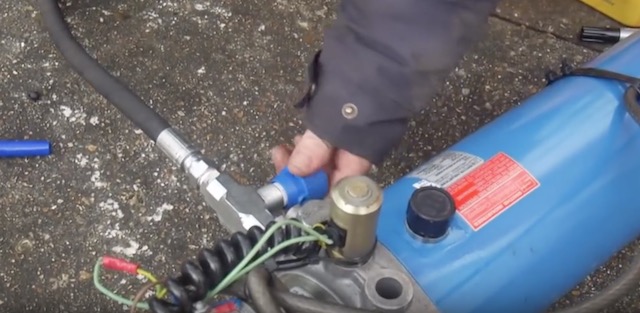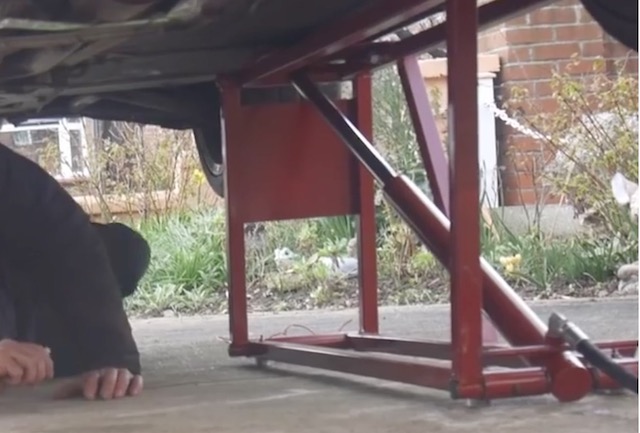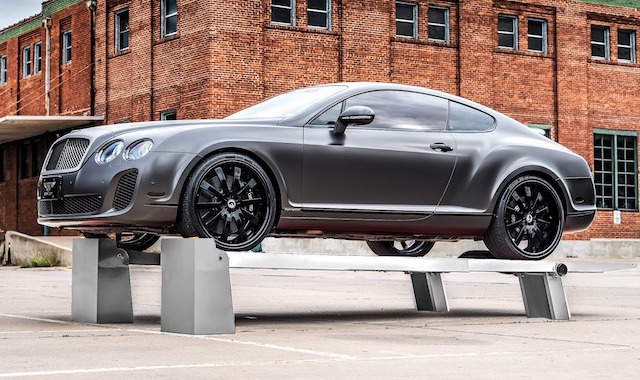
What does “portable” mean? Let’s say moving a car lift requires:
- 2 people
- Towels and rags for cleaning up hydraulic fluid spills
- Buckets to hold hoses and spilled fluid
- Extra hydraulic fluid to replace leaked fluid –
Is that car lift actually portable?
The Kwik-Lift has always been portable, and most of the companies that try to compete with our product also claim that their lifts are portable. However, as we’ll explain below, some of the entry-level hydraulic lifts on the market today are marketed as portable, but they’re actually not.
What Does Portable Mean To Kwik-Lift?

To most people, portable means 3 things:
- You can move it from one location to another with ease.
- You don’t have to do a bunch of clean-up every time you move it.
- You don’t need someone to help you.
If you buy a Kwik-Lift, here’s what portable means. First, you need a truck bed or trailer to be able to haul all the lift parts. You also need a socket wrench and about 10 minutes of your time. To dismantle your Kwik-Lift, you need to lower it, take your vehicle off of it, and start loosening bolts. Each piece is easily carried by one person, and everything comes apart quickly. Once all the parts are loaded into your truck or trailer, you’re ready to go.
When you get to your destination, you reassemble the lift in about 10 minutes. Again, each piece is light enough to be moved by one person, and all you need is hand tools. That’s all.
What Does Portable Mean To Other Lift Manufacturers?

If you buy an entry-level hydraulic lift, this is what you can expect in terms of portability:
- Each side of your lift will weigh no less than 60 pounds. In some cases, it could even weigh over 100 pounds. Each side will also be several feet long. Are you a long-armed athlete who enjoys lifting weights in your spare time? If not, you’re going to want someone to help you get each side of your “portable” lift into the back of your pickup.
- However, before you can lift anything, you’ve got to deal with hydraulic hoses and fluids. Hoses must be disconnected, which means you’re going to have to clean up a couple of small spills. Then, because hoses are never quite ’empty’, you’re going to want a bucket to hold the hoses you disconnected.
- However, you can’t disconnect any hoses until you release all the pressure from the system. Then you will need to cap everything off so there are no leaks from the main hydraulic cylinder during transport.
- Still, there will be some leaked fluid, so you’ll want to bring some replacement fluid with you.
- When it’s time to set up the lift somewhere else, you’ll need a buddy to help you unload, and then you can reconnect everything.
- Once the whole system is reconnected and you’ve cleaned up some more hydraulic fluid, it’s time to check fluid levels, top off, and then bleed the system.
Sounds easy, right?
When It Comes To Lifts, Hydraulics Really Aren’t That Portable

While technically these entry-level hydraulic lifts are portable, it’s fair to say that they just aren’t that easy to move. Anytime you’re dealing with connecting and disconnecting hoses, you’re going to have to deal with leaks. Any time you’ve got leaks, you’re going to have to deal with fluid replacement and bleeding. It’s not a big deal, but it’s not easy, either.
The Kwik-Lift is designed so that one person can setup and tear down the lift quickly and easily. That’s because the man that designed it was a DIY’er himself. After he was severely injured by a jack stand accident, he made it his mission in life to build a lift that was safe, easy to use, and functional in a home garage. A guy like this doesn’t want a lift that requires any help or hassle when it’s time to move.
Frankly, we don’t think anyone should have to phone a friend and prepare for a possible hazmat spill before moving a car lift in their home garage. Moving a lift should be as easy as loosening a few bolts and moving a few parts.
With the Kwik-Lift, that’s exactly what you get.



